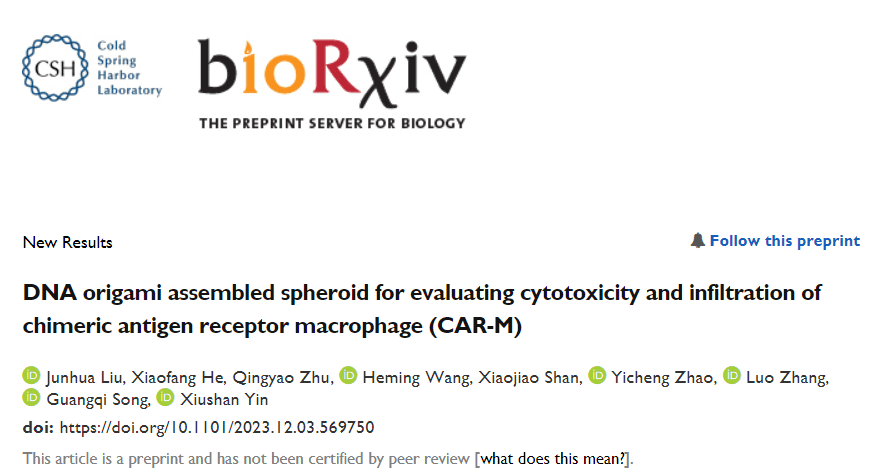
Recently, the research from the strategic collaboration between 『RocRock Biotechnology』 and 『Puheng Technology』 has been uploaded to the life science preprint platform "bioRxiv" under the title "DNA origami assembled spheroid for evaluating cytotoxicity and infiltration of chimeric antigen receptor macrophage (CAR-M)", available at https://www.biorxiv.org/content/10.1101/2023.12.03.569750v1. This study emphasizes the use of a 3D NACs-origami assembled micro-tumor spheroid model to evaluate the targeted recruitment, killing, and infiltration abilities of CAR-M, with the goal of offering an efficient high-throughput validation platform for novel target discovery and pharmacological assessment of CAR-M.

Introduction
Over the past few years, CAR-T cell therapy has made significant breakthroughs in treating hematological malignancies, gaining FDA approval and ushering in the cell therapy era. Yet, it faces challenges in solid tumor treatment due to issues like poor infiltration and a complex tumor microenvironment. This has spurred the emergence of CAR-M as a promising alternative with its potent immune infiltration and cytotoxicity, offering hope for more effective solid tumor treatment.
CAR-M involves engineering macrophages with specific synthetic transmembrane receptors, known as chimeric antigen receptors (CARs). This modification enhances the macrophages' ability to recognize and target tumor antigens in solid tumors, maximizing their phagocytic and cytotoxic potential. Moreover, CAR-M boosts antigen presentation, amplifies T cell cytotoxicity, and improves the phenotype of tumor-associated macrophages within the tumor microenvironment, creating a more favorable condition for solid tumor elimination.
The 3D NACs-origami assembled spheroid is a 3D micro-tumor spheroid model built with biological nucleic acid materials as the carrier through DNA origami technology, also termed NAC-organ technology. In this paper, we used this technology to construct 3D ovarian cancer tumor microspheres, which require no matrix gel support and are suitable for long-term culture. PBMC infiltration assay results indicate that this model can effectively mimic the interaction between tumor cells and immune cells, allowing immune cells to actively invade the tumor model and thus accurately replicate the tumor immune microenvironment.
The 2D co-culture model was used to evaluate CAR-M's performance. It turned out that CAR-M had strong phagocytosis and cytotoxicity.
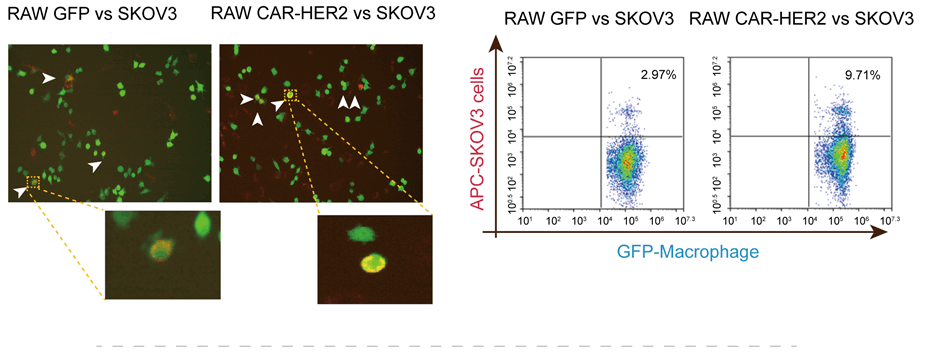
(Figure 1)
Figure 1 Phagocytosis Efficiency Evaluation In the left - panel fluorescence - based evaluation, target SKOV3 cells are labeled using pHrodo SE dye. After a 6 - hour co - culture of CAR-M and target cells, the microscope clearly shows more phagocytosis events in the CAR-M group.
For the right - panel flow - cytometry - based evaluation, FarRed - labeled SKOV3 cells are used. After co - culturing with CAR-M for 6 hours, the phagocytosis ratio of CAR-M cells is much higher than that of the control.
PBMCs and 3D tumor microspheres interact to create a tumor immune microenvironment.
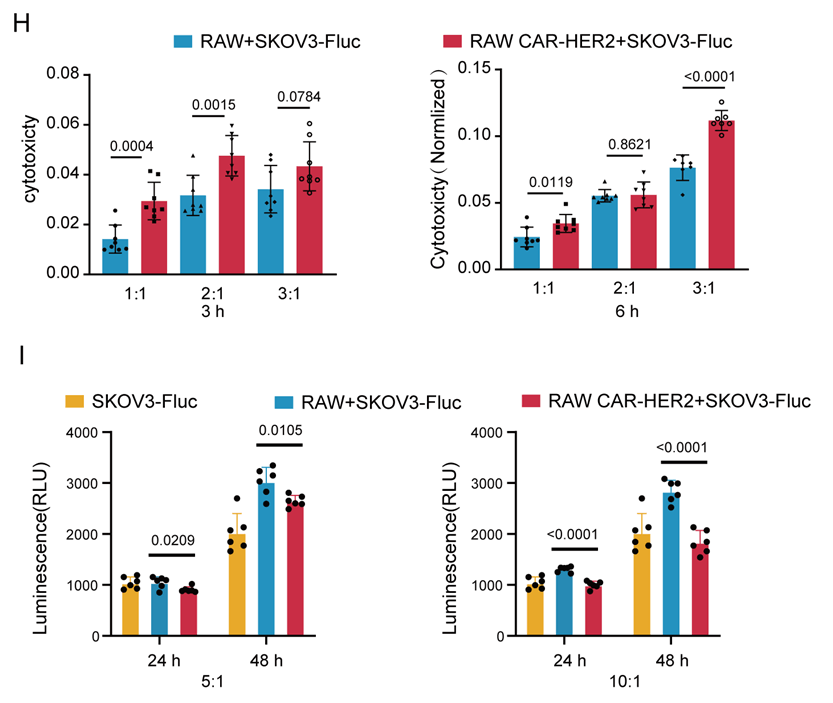
(Figure 2)
Figure 2 Evaluation of Cytotoxicity Both LDH - based (H) and Firefly luciferase - based (I) methods demonstrate CAR-M's remarkable cytotoxicity, which changes with different E/T ratios and time points. With an increasing E:T ratio, CAR-M's cytotoxicity shows a tendency to increase.In short, results from the 2D co-culture model collectively reveal that CAR-M possesses significant phagocytic and cytotoxic activities.
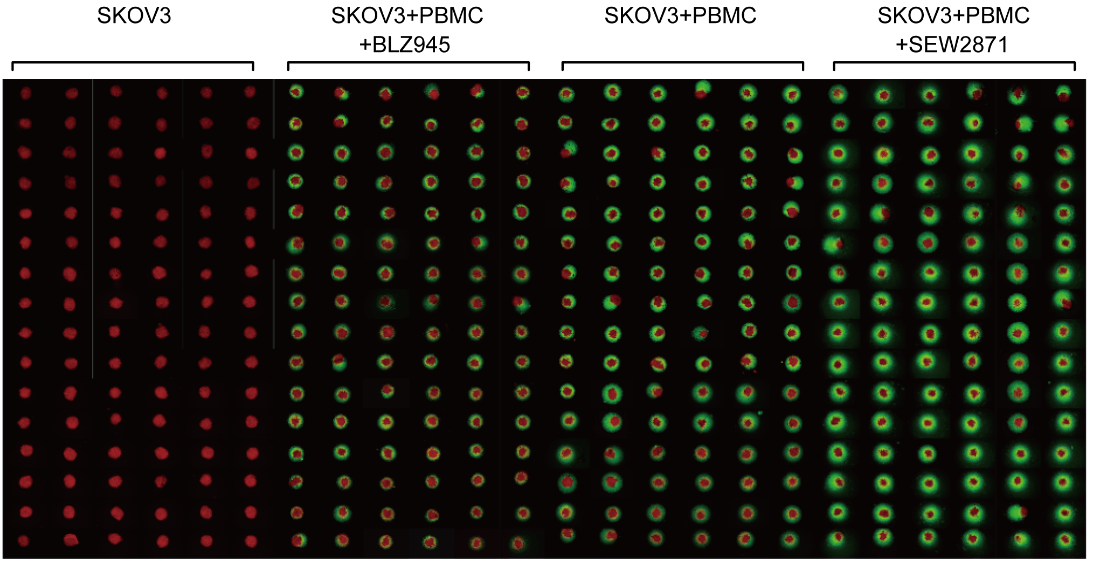
(Figure 3)
Figure 3 High-throughput Interaction Model between PBMC and 3D Tumor Microsphere (384-well plate)
After constructing the 3D micro-tumor model for 24 hours, mouse PBMCs, PBMCs with immune cell inhibitor BLZ945, and PBMCs with immune stimulant SEW2871 were added respectively. The results show that PBMCs exhibit invasive behavior towards the 3D micro-tumor spheroids.
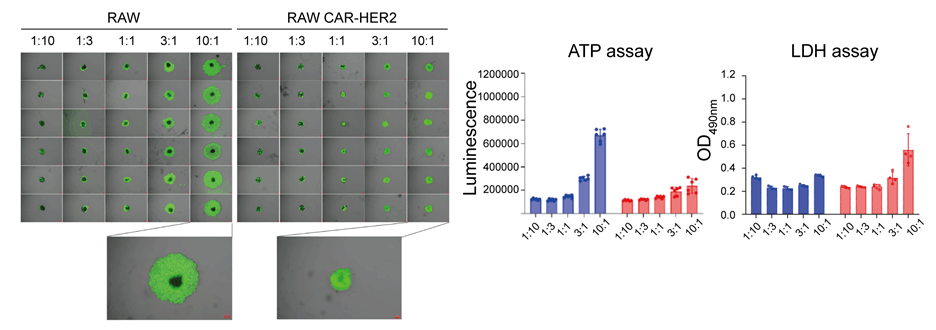
(Figure 4)
Figure 4 Assessment of CAR-M Cell Targeting and Infiltration Ability on 3D Tumor Microsphere
GFP-labeled M/CAR-M cells were introduced into the 3D tumor microsphere model. After 48 hours, it was found that 95% of the CAR-M cells had infiltrated the model, demonstrating their significant targeting and infiltration capabilities towards the 3D tumor microsphere (SKOV3 microsphere) model. Through ATP and LDH detection, it was further confirmed that CAR-M has stronger cytotoxicity against the 3D tumor microsphere.
In summary, we have developed a 3D tumor spheroid system using NACs-origami assembly technology to evaluate CAR-Ms in vitro. This platform is highly beneficial for validating other targets of CAR-Ms, assessing their effects on other tumors, and evaluating CAR-M combination therapies. By accelerating CAR-M clinical research, it offers strong and reliable support for future clinical treatments.
DNA orgami assembled spheroid for evaluating cytotoxicity and infiltration of chimeric antigen receptor macrophage (CAR-M) Source doi: https://doi.org/10.1101/2023.12.03.569750
Best AI Website Creator